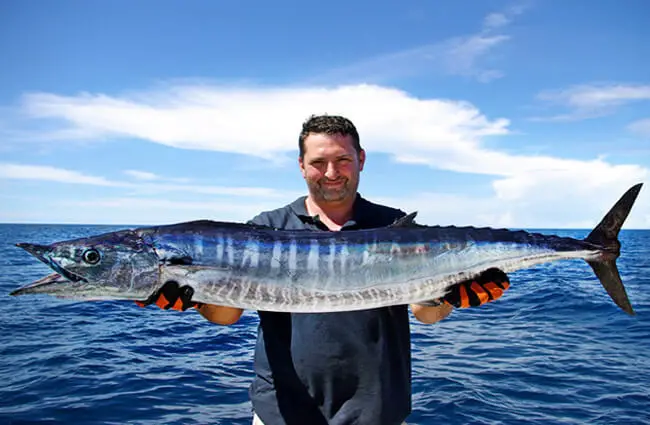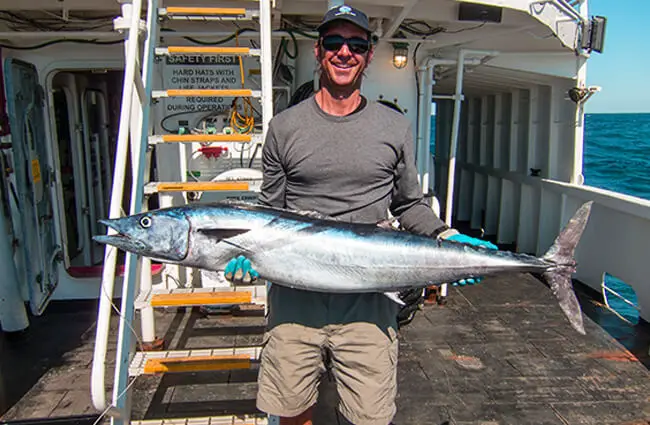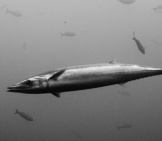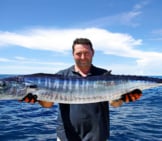The Wahoo is a species of Spanish mackerel in the Scombridae family. Other members of the family include tuna, bonito, mackerel, and more. Researchers place this species in the Scomberomorini tribe, along with the other Spanish mackerels.
People prize this well-known species as a sport fish for its speed and powerful swimming. Read on to learn about the Wahoo.
Description of the Wahoo
This fish has silvery colored scales with a dark, blue-green colored back. Its sides, or flanks, have light blue stripes or barring. People often mistake this species for a barracuda for this reason. Adults typically reach about five or six feet long, but exceptionally large individuals can surpass eight feet in length.
Interesting Facts About the Wahoo
People often target this species as a game fish. Learn more about what makes them unique, below.
- Hawaiian Cuisine – People in Hawaii call this species of fish “ono.” The word roughly translates to “good to eat.”
- What’s in a Name – Ironically enough, the common name of this species also came from the Hawaiian Islands. When Europeans first encountered the islands of Hawaii, they often misspelled Oahu as “Wahoo.” This misunderstanding led to the European term for this species.
- Recreational Fishing – Many people target this species as a sport or game fish. They enjoy catching this fish because it reaches relatively large sizes, and poses some difficulty to reel in because of its powerful swimming.
Habitat of the Wahoo
You can find this species both close to shore and in the open ocean. It inhabits epipelagic ecosystems, or the area from the surface of the water to as deep as light continues to penetrate. This species ranges as far as 1,000 feet beneath the surface.
Distribution of the Wahoo
These fish range throughout tropical and subtropical seas, and also live in some temperate zones as well. You can find them across the central Pacific Ocean from the Indo-Pacific region to the Americas. On the west coast of North America, they range from southern California, through Mexico, to Central and northern South America.
They also range throughout the western Atlantic Ocean from the southeast United States to South America. You can also find them in the Mediterranean and Ionian seas, as well as regions off the coast of Africa. Finally, they also live throughout the Indian Ocean.
Diet of the Wahoo
These fish have powerful and capable hunting abilities. They swim in active pursuit of prey, and have carnivorous feeding habits. Some common prey items include squid, flying fish, halfbeak, gurnard, and more. Their diet varies based on where they live and how large they are.
Wahoo and Human Interaction
Humans catch this species both recreationally and commercially. People in many areas eat the meat of this species. Additionally, fisheries targeting other species also accidentally catch this species as bycatch. This activity threatens these fish to some extent. However, they currently have stable populations and the IUCN lists them as Least Concern.
Domestication
People have not domesticated this species in any way.
Does the Wahoo Make a Good Pet
No, you could not keep this fish as a pet. They grow quite large and would not fit in a home aquarium.
Wahoo Care
Aquariums do not generally keep this species of fish. As large, powerful predators, they naturally live in the open ocean. For this reason, you would need to house them in massive tanks, and they would prey upon other fish species in the tank as well. This makes them impractical in an aquarium setting.
Behavior of the Wahoo
For the most part, this fish lives a solitary life. Occasionally, you can find them in pairs or small, loosely associated groups, especially around plentiful food sources. They have active behavior, and move swiftly in pursuit of their prey rather than using camouflage or ambush hunting methods.
Reproduction of the Wahoo
Like other members of the Scombridae family, this species reproduces via spawning. This means that they release their eggs and sperm into the water and fertilization occurs externally, or outside of the body. A single female can produce a million eggs or more! The young typically reach sexual maturity at a year old.





![This Wahoo was caught in the Gulf of Mexico This Wahoo was caught in the Gulf of Mexico NOAA/NMFS/SEFSC Pascagoula Laboratory; Collection of Brandi Noble [Public domain]](https://animals.net/wp-content/uploads/2020/02/Wahoo-4-650x425.jpg)





![This Wahoo was caught in the Gulf of Mexico This Wahoo Was Caught In The Gulf Of Mexico Noaa/Nmfs/Sefsc Pascagoula Laboratory; Collection Of Brandi Noble [Public Domain]](https://animals.net/wp-content/uploads/2020/02/Wahoo-4-162x141.jpg)

![Red Angus Closeup of a beautiful Red Angus cowPhoto by: U.S. Department of Agriculture [pubic domain]https://creativecommons.org/licenses/by/2.0/](https://animals.net/wp-content/uploads/2020/03/Red-Angus-4-238x178.jpg)












![Red Angus Closeup of a beautiful Red Angus cowPhoto by: U.S. Department of Agriculture [pubic domain]https://creativecommons.org/licenses/by/2.0/](https://animals.net/wp-content/uploads/2020/03/Red-Angus-4-100x75.jpg)

